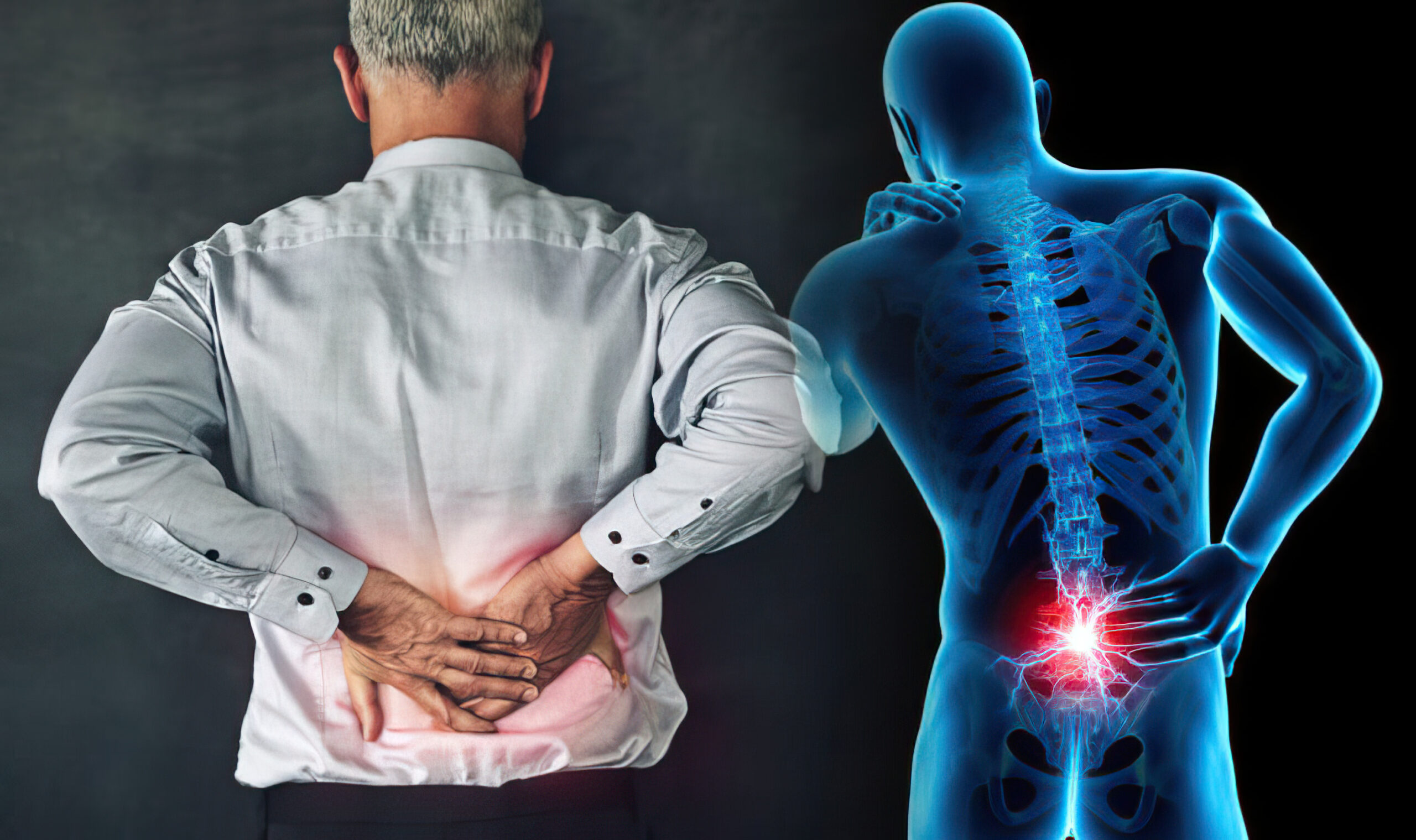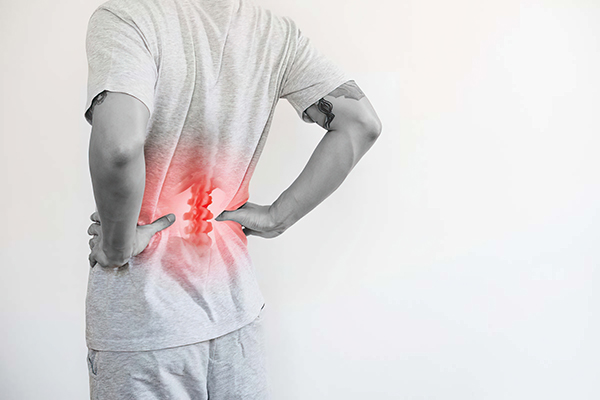LOW BACK PAIN


ANATOMY OF LOWER BACK
Lumbar Vertebrae
The lumbar spine contains 5 moderately large vertebrae which sit atop the sacrum. These bony segments act as attachments for muscles and ligaments in the lumbar spine and also encase and protect the lower spinal cord and lumbar nerve roots.
Because the lumbar vertebrae are located between the pelvis and upper torso, the degree of stress endured by the lumbar spine is great. These abnormally high degrees of stress result in frequent lumbar vertebral subluxations – misalignments and improper motion patterns of the lumbar vertebrae. If left uncorrected, these misalignments and faulty biomechanics of the lower spine can result in spinal injury and irreversible degenerative changes.
Lumbar Intervertebral Discs
The lumbar discs connect adjacent lumbar vertebrae to one another and cushion the spine as well as permit motion between the individual vertebrae. As stated above, the lumbar spine is a “transitional” area between the pelvis and upper torso, thus, resulting in high degrees of spinal stress. This results in the 4th and 5th lumbar discs suffering more injuries than all other spinal discs combined.
Disc herniations in the lumbar spine are the most common causes of “sciatica”, meaning pain running down the back of the leg in the area of the sciatic nerve. Possible symptoms include pain, numbness, tingling, or weakness in the legs and/or feet.
In rare cases, a lumbar disc herniation can compress the spinal nerves which provide motor control to the bowel and bladder. Although rare, if you’re having back pain and experience a loss of bowel and/or bladder control, immediate medical intervention is required. Without immediate decompression, the loss may become permanent.
Lumbar Facet Joints
The facet joints in the lumbar spine allow for considerable amounts of flexion but a much lesser degree of extension and rotation. These joints must withstand large amounts of stress from the body and as a result, are prone to acute and repetitive injuries and degenerative arthritis.
Facet joints are most commonly injured during movements involving a rotational or twisting component. When injured, pain is often sharp and localized to the area of the affected facet joint. Later in life, if spinal problems have been allowed to linger without appropriate rehabilitation, arthritis will likely be present. If severe enough, as is commonly the case, bony arthritic enlargement of the joint can impinge upon spinal nerve roots and produce symptoms of pain, numbness, and tingling down the leg, as well as leg weakness, in addition to back pain.
Lumbar Spinal Nerves
The lumbar spinal nerve roots exit openings formed between adjacent lumbar vertebrae termed the intervertebral foramina or IVF. The weakest aspect of the spinal disc is unfortunately in close proximity to the IVF. Thus, disc injuries commonly result in discal materials compressing, stretching, or irritating the nerve roots exiting the IVF’s.
Because the nerve roots exiting the lumbar spine innervate structures in the lower extremities, any compression, stretching, or other irritation will result in numbness, tingling, pain, or weakness in the leg(s) and/or feet. This may result from vertebral malpositions, disc herniations, arthritic changes to the vertebrae and facet joints, or even abnormalities within the muscles (piriformis syndrome).
Lumbar Spinal Musculature
The paraspinal muscles in the lumbar spine attach to the spinal vertebrae and pelvis to provide the torso with movement. These muscles must be strong to control the upper torso about the pelvis and thus are frequently overworked and injured. The pain associated with paraspinal muscle injury is generally a dull, boring, generalized ache in the area of the lower back.
Sacroiliac Joint
The sacroiliac joints are located between the sacrum and the ilium bones of the pelvis. These joints may also become irritated or injured resulting in lower back pain, buttock pain, and occasionally leg pain.
This condition tends to be more common in women, especially during pregnancy when hormonal changes and pressure from the forming fetus increase the stress on these joints.


TREATMENTS FOR LOW BACK PAIN
Chiropractors successfully treat thousands of headache sufferers every day. According to surveys, as many as 25% of the individuals seeking chiropractic care do so for the treatment of headaches.
Chiropractic has such good success in the treatment of headaches because most headaches are either soft tissue or neurologic in nature. Also, a significant portion of headaches originates in the tissues of the neck. And since chiropractors focus their treatment on the soft tissues of the spine, which includes the neck, the majority of headaches can be successfully managed with appropriate chiropractic care. Best of all, chiropractic treatments consist of only safe, natural, and noninvasive therapies that focus on correcting the cause of headaches, and not simply the short-term masking of symptoms.
Chiropractic treatment for headaches has been compared with other forms of treatments and in most cases, has excelled. To see the results of studies evaluating the effectiveness of chiropractic care in the treatment of different headache types, select the “Articles” link from the table above.
CAUSES OF LOW BACK PAIN
Many tissues can generate low back pain. Unfortunately, research shows that the exact tissues causing low back pain cannot be specifically identified in up to 80% of individuals. In other words, we cannot single out the tissue(s) responsible for the pain. These patients are said to suffer from “nonspecific low back pain”; the specific cause of the pain cannot be determined.
Although the specific tissues causing low back pain are difficult to identify, chiropractic doctors have found a number of factors consistently present in low back pain patients. These factors include vertebral subluxations, faulty spinal biomechanics, deconditioned spinal musculature, and the practice of poor postural habits and techniques. By addressing these factors – the actual causes of the tissue injury – chiropractic doctors are able to obtain extraordinary results in low back pain sufferers.
Common events leading or contributing to the development of lower back pain include:
- Incomplete rehabilitation of past injuries
- Lack of proper and periodic lumbar spinal alignments
- Presence of lumbar spine subluxations
- Improper lifting techniques
- Auto accidents
- Improper workstation setup
- Poor posture
- Prolonged sitting
- Prolonged use of non-ergonomically designed equipment
- Excessive repetitive torsal motions
- Exposure to vibratory forces (truck drivers, jackhammer operators)
- Scoliosis (lateral deviation of the spine)
- Fallen foot arches and other foot abnormalities
- Physical inactivity
- Poor diet and nutritional practices
- Smoking
Structures that are often the source of lower back pain include:
- Lumbar intervertebral discs
- Lumbar facet joints and joint capsules
- Lumbar and pelvic muscles and ligaments
- Lumbar and sacral spinal nerves
- Sacroiliac joints

